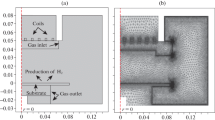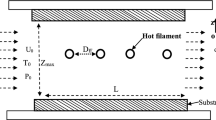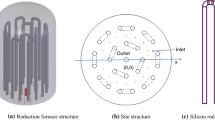Abstract
The effect of characteristics flow (contour of velocity), mass transfer (Sherwood number) and heat transfer (Nu number) on the growth rate of silicon carbide by means of plasma-enhanced chemical vapor deposition vertical reactor is investigated. The species transport and thermal fluid transport with chemical reaction are taken into account. The steady-state laminar fluid flow and gas flow having ideal behavior are considered. A mixture of silane and propane (2% molar) as main reactant gases and hydrogen (96% molar) as propellant gas are injected into the reactor. Four different diameters of shower head, three different substrate rotation speeds and five different temperatures of the substrate are used. The finite volume method is employed to solve the problem. The governing equations are solved by upwind differencing scheme. The assumption of speed–pressure coupling leads to use of semi-implicit method for pressure-linked equations to solve the governing equation. It is found that the deposition rate reduces with the shower head diameter and value of substrate temperature and enhances with rotational speed of the substrate. Furthermore, the best shower head diameter to achieve maximum rate of deposition is 1 mm. At the end, a comparison as a limiting case of the considered problem with the existing studies is made. Comparing the results of this experiment with prior studies has shown acceptable consistency.













Similar content being viewed by others
Abbreviations
- \(A_{\text{r}}\) :
-
Pre-exponential factor of reaction
- \(c_{\text{p}}\) :
-
Specific heat of gas mixture (J mol−1 K−1)
- \(c_{j,r}\) :
-
Molar concentration
- \(D_{i}\) :
-
Effective diffusion coefficient
- D :
-
Diameter (m)
- \(E\,\) :
-
Energy (J)
- \(E_{\text{r}}\) :
-
Activation energy of the reactions
- \(g\) :
-
Gravity force
- \(j_{i}\) :
-
Mass flux of species
- \(k_{{{\text{f}},{\text{r}}}}\) :
-
Rate constant of forward reaction
- \(M_{i}\) :
-
Molar mass of species
- \(m\,\) :
-
Mass (kg)
- \(P\) :
-
Power (watt)
- \(P\) :
-
Pressure (Pa)
- SCCM:
-
Standard cubic centimeters per minute
- SDR:
-
Surface deposition rate (Kg m−2 S−1)
- \(R\) :
-
Gas constant (J mol−1 K−1)
- \(R_{i}\) :
-
Species net molar reaction rate
- \(R_{i,r}\) :
-
Net molar reaction rates of species i
- \(T\,(^\circ {\text{C}})\) :
-
Temperature of gas mixture
- \(U\,({\text{ms}}^{ - 1} )\) :
-
Velocity of gas mixture
- \(\beta_{\text{r}}\) :
-
Thermal index
- \(\eta_{j,r}^{'}\) :
-
Speed index for positive reaction of reactant or product j
- λ :
-
Coefficient of heat conduction
- µ :
-
Dynamic viscosity of gas mixture
- \(\rho\) :
-
Density of gas mixture
- δ :
-
Unit tensor
- \(\tau\) :
-
Viscous stress
- \(w_{i}\) :
-
Mass fraction of species
- i, j:
-
Represent ith/jth species
References
Tong L, Mehregany M, Tang WC (1993) Amorphous silicon carbide films by plasma-enhanced chemical vapor deposition. In: Proceedings IEEE micro electro mechanical systems. Fort Lauderdale, FL, pp 242–247
Mackenzie KD, Reelfs B, DeVre MW, Westerman R, Johnson DJ (2004) Characterization & optimization of low stress PECVD silicon nitride for production GaAs manufacturing. Unaxis USA Inc., St. Petersburg, FL
Choi WS, Hong B, Jeon Y, Kim K, Yi J (2004) Synthesis and characterization of diamond-like carbon protective ar coating. Korean Phys Soc 45:864–867
Ding J, Zhao Y, Yuan N, Shubo M, Wang C, Ye F, Kan B (2011) Effect of electrode architecture and process parameters on distribution of SiH3 in a PECVD system. Vacuum 86:344–349
Jeong YM, Lee JK, Jun HW, Kim GR, Choe Y (2009) Preparation of super-hydrophilic amorphous titanium dioxide thin film via PECVD process and its application to dehumidifying heat exchangers. Ind Eng Chem 15:202–206
Chowdhury A, Mukhopadhyay S, Ray S (2008) Effect of gas flow rates on PECVD-deposited nanocrystalline silicon thin film and solar cell properties. Solar Energy Mater Solar Cells 92:385–392
Baek JS, Kim YJ (2007) Characteristics of thermal-flow fields in a PECVD reactor with various operating conditions. Korean Phys Soc 51:1113–1118
Wang ZJ, Feng X, Shang XF (2011) The simulation of polycrystalline silicon thin film deposition in PECVD system. Adv Mater Res 189:2032–2036
Colomboa FB, Carreño MNP (2012) Simulation of PECVD SiO2 deposition using a cellular automata approach. ECS Trans 49:297–304
Marin M, Marinescu C (1998) Thermoelasticity of initially stressed bodies, asymptotic equipartition of energies. Int J Eng Sci 36(1):73–86
Marin M, Lupu M (1998) On harmonic vibrations in thermoelasticity of micropolar bodies. J Vib Control 4(5):507–518
Marin M (2010) A domain of influence theorem for microstretch elastic materials. Nonlinear Anal RWA 11(5):3446–3452
Sher Akbar N, Tripathi D, Khan ZH, Anwar Bég O (2016) A numerical study of magnetohydrodynamic transport of nanofluids over a vertical stretching sheet with exponential temperature-dependent viscosity and buoyancy effects. Chem Phys Lett 661:20–30
Sher Akbar N, Tripathi D, Anwar Bég O (2016) Modeling nanoparticle geometry effects on peristaltic pumping of medical magnetohydrodynamic nanofluids with heat transfer. J Mech Med Biol 16(06):1650088–1650108
Sher Akbar N, Kazmi N, TripathiD Mir NA (2016) Study of heat transfer on physiological driven movement with CNT nanofluids and variable viscosity. Comput Methods Progr Biomed 136:21–29
Sher Akbar N, Tripathi D, Anwar Bég O (2017) MHD convective heat transfer of nanofluids through a flexible tube with buoyancy: a study of nano-particle shape effects. Adv Powder Technol 28(2):453–462
Sher Akbar N, Bintul Huda A, Tripathi D (2017) Thermally developing MHD peristaltic transport of nanofluids with velocity and thermal slip effects. Eur Phys J Plus 131(9):332
Kleijin CR (1995) Chemical vapor deposition processes, chapter 4. Artech House, Boston
Pflűger A, Schröder B (2002) Simulations of the gas flux distribution for different gas showers and filament geometries on the large-area deposition of amorphous silicon by hot-wire CVD. J Non Cryst Solids 299–302(1):36–41
ChengWT Li HC, Huang CN (2008) Simulation and optimization of silicon thermal CVD through CFD integrating Taguchi method. Chem Eng J 137(3):603–613
Pawlowski RP, Theodoropoulos C, Salinger AG, Mountziaris TJ, Moffat HK, Shadid JN, Thrush EJ (2000) Fundamental models of the metalorganic vapor-phase epitaxy of gallium nitride and their use in reactor design. J Cryst Growth 221:622–628
Hamby ES, Demos AT, Kabamba PT, Khargonekar PP (1995) A control oriented modeling methodology for plasma enhanced chemical vapor deposition processes American Control Conference, USA
Soong CY, Chyuan C, Tzong RY (1998) Thermo-flow structure and epitaxial uniformity in large-scale metalorganic chemical vapor deposition reactors with rotating susceptor and inlet flow control. Jpn J Appl Phys Part 1 37:5823–5834
Zhi-Meng W, Qing-Song L, Xin-Hua G, Ying Z, Jian S, Jian-Ping X (2006) Effect of substrate temperature and pressure on properties of microcrystalline silicon films. Chin Phys 15(6):1320–1324
Cho HS, Choi DJ (2009) The study of dielectric constant change of a-SiC: H films deposited by remote PECVD with low deposition temperatures. Korean Phys Soc 55(5):1920–1924
Pokhodnya K, Sandstrom J, Dai X, Boudjouk P, Schulz DL (2009) Comparative study of low-temperature PECVD of amorphous silicon using mono-, di-, trisilane and cyclohexasilane. In: 34th IEEE photovoltaic specialists conference (PVSC). Philadelphia, PA, pp 001758–001760
Liu L, Liu W, Cao N, Cai C (2013) Study on the performance of PECVD silicon nitride thin films. Def Technol 9:121–126
Qing-Song L, Zhi-Meng W, Xin-HuaG Ying Z, Jian S, Jian-Ping X (2006) Effect of substrate temperature on the growth and properties of boron-doped microcrystalline silicon films. Chin Phys 15(1):213–218
Hamui L, Monroy BM, Kim KH, López-Suárez A, Santoyo-Salazar J, López-Lópeze M, Cabarrocas PRI, Santana G (2016) Effect of deposition temperature on polymorphous silicon thin films by PECVD: role of hydrogen. Mater Sci Semicond Process 41:390–397
Huang H, Winchester KJ, Suvorova A, Lawn BR, Liu Y, Hu XZ, Dell JM, Faraone L (2006) Effect of deposition conditions on mechanical properties of low-temperature PECVD silicon nitride films. Mater Sci Eng A 435–436:453–459
Phillips B, Rodriguez RG, Lau LD, Steidley SD (2004) Effect of showerhead configuration on coherent Raman spectroscopically monitored pulsed radio frequency plasma enhanced chemical vapor. Plasma Chem Plasma Process 24(2):307–323
Cheng H, Wu A, Xia J, Shi N, Wen L (2009) Effects of Substrate temperature on the growth of polycrystalline Si films deposited with SiH4 + Ar. J Mater Sci Technol 25(4):489–491
Moravej M, Babayan SE, Nowling GR, Yang X, Hicks RF (2004) Plasma enhanced chemical vapour deposition of hydrogenated amorphous silicon at atmospheric pressure. Plasma Sources Sci Technol 13:8–14
Lee CH, Wong WS, SazonovA Nathan A (2015) Study of deposition temperature on high crystallinity nanocrystalline silicon thin films with in-situ hydrogen plasma-passivated grains. Thin Solid Films 597(31):151–157
Gu L, Yang H, Wen G, Li Y, (2011) Substrate temperature influence on properties of amorphous silicon-germanium thin films prepared by RF-PECVD. In: Symposium on Photonics and Optoelectronics (SOPO)
Sarmid S, Oeraman K, Ismail B, Sakrani S (2006) Effect of substrate temperature on the properties of diamond-like carbon deposited by PECVD in methane atmosphere. In: Proceedings of Annual Fundamental Scion Seminar 2006, AFSS 20061, 6–7 June 2006
Author information
Authors and Affiliations
Corresponding author
Ethics declarations
Conflict of interest
The authors have declared that they have no actual or potential conflict of interest including any financial, personal or other relationships with other people or organizations.
Rights and permissions
About this article
Cite this article
Shirvan, K.M., Ellahi, R., Sheikholeslami, T.F. et al. Numerical investigation of heat and mass transfer flow under the influence of silicon carbide by means of plasma-enhanced chemical vapor deposition vertical reactor. Neural Comput & Applic 30, 3721–3731 (2018). https://doi.org/10.1007/s00521-017-2954-3
Received:
Accepted:
Published:
Issue Date:
DOI: https://doi.org/10.1007/s00521-017-2954-3




